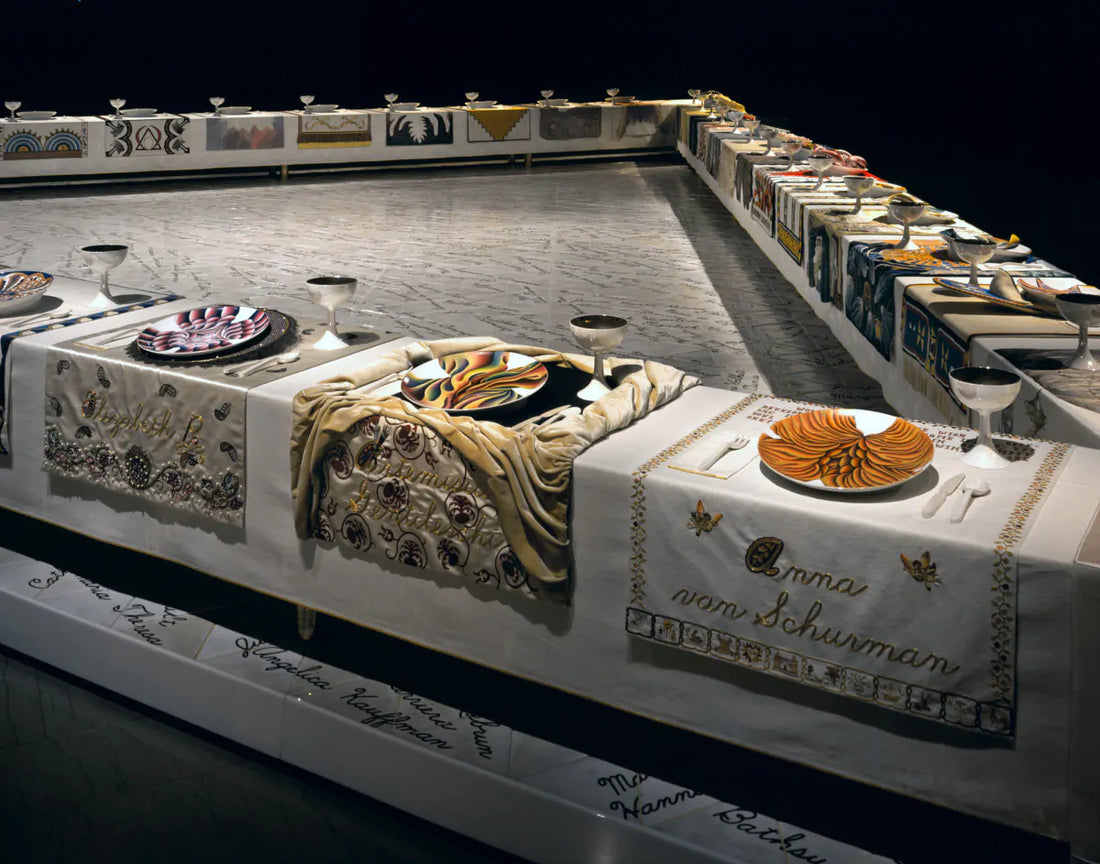Featured Image: The Dinner Party (1974-1979) by Judy Chicago
Art critics view works of art from range of perspectives, from aesthetics to socio-political contexts.
Art criticism is the thoughtful evaluation and interpretation of contemporary art, exploring its meaning, techniques, and social context. Critics play a pivotal role in shaping artistic understanding, fostering dialogue, and contributing to a deeper appreciation of art's impact on society and culture.
Explore our curated selection of contemporary artists from around the globe.
Naturalist Gallery offers artist representation internationally. Apply your art.

Les Sucriers (1921) by Fernand Léger
Art criticism is not limited to negative opinions but also includes positive appreciation and exploration of artistic expressions. The critic plays a significant role in interpreting the meaning and value of art, shaping art history, and contributing to the establishment of artistic canons. Throughout history, art criticism has been influenced by various philosophical and theoretical perspectives, which have evolved alongside different cultural and historical contexts.
I. The Role of the Critic:
A competent art critic is not merely a connoisseur with extensive knowledge of art history; they are also capable of forming judgments about new and unfamiliar works of art. The critic faces the challenge of either defending established norms and values or advocating for innovative art that challenges conventions. Extreme innovators, whose work is radically different, present the greatest challenge to the critic, forcing them to explore new approaches or rely on established assumptions. The critic's perception of social needs and underlying theoretical bases, such as Marxism or feminism, can significantly influence their evaluations of art.

The Treachery of Images (1929) by René Magritte
- The role of the critic goes beyond being a connoisseur, requiring the ability to make judgments about contemporary art.
- Critics may choose to defend traditional art standards or advocate for groundbreaking, disruptive art.
- Extreme innovators pose the greatest challenge to critics, pushing them to reconsider their understanding of art.
- The critic's perception of social needs, influenced by theoretical bases, impacts their evaluations of art.
II. Foundations of Art Criticism in Antiquity and the Middle Ages:
Philosophers like Plato, Aristotle, and Plotinus laid the groundwork for art criticism in antiquity. Plato regarded art as a mere imitation of reality, with the artist dealing with appearances rather than absolute truths. Aristotle, on the other hand, recognized the moral and cathartic aspect of art, emphasizing its value in understanding human character. Plotinus introduced the idea that art can reflect higher spiritual beauty, elevating artistic beauty to a sacred and abstract level.

The Birth of Venus (1484-1486) by Sandro Botticelli
- Philosophers in antiquity, such as Plato and Aristotle, had early ideas about art criticism.
- Plato viewed art as an imitation of reality, while Aristotle emphasized the moral and cathartic aspects of art.
- Plotinus introduced the concept of art reflecting higher spiritual beauty, giving art a sacred and abstract quality.
III. Development of Art Criticism in Modern Times:
Art criticism in modern times saw the emergence of various schools of thought, including formalism, abstract expressionism, and feminist art criticism. Critics like Roger Fry and Clive Bell championed post-Impressionist and abstract art, praising works that explored pure imagination over traditional representation. Meanwhile, the Marxist art critic Clement Greenberg supported abstract expressionism as the epitome of aesthetic value, advocating for the purity of artistic form.

Untitled (I shop, therefore I am) (1987) by Barbara Kruger
- Modern art criticism witnessed the rise of various schools, including formalism and abstract expressionism.
- Critics like Roger Fry and Clive Bell celebrated post-Impressionist and abstract art for their pure imagination.
- Clement Greenberg's Marxist perspective supported abstract expressionism for its aesthetic value and pure form.
IV. Contemporary Art Criticism:
Contemporary art criticism continues to evolve with new technologies and modes of communication. Art critics now write for print media, online platforms, and television, engaging with audiences through various channels. The practice of art criticism includes descriptive aspects, analyzing the techniques and materials used in a work of art. It may also involve interpretation, delving into the meaning and social context of the artwork. Evaluative criticism assesses the quality and significance of the art piece.

One and Three Chairs (1965) by Joseph Kosuth
- Contemporary art criticism adapts to new technologies and platforms, reaching diverse audiences.
- Critics engage in descriptive analysis, exploring the techniques and materials used in artworks.
- Interpretative criticism delves into the meaning and social context of art.
- Evaluative criticism assesses the quality and significance of art pieces.
V. The Importance of Art Criticism:
Art criticism plays a vital role in fostering dialogue, encouraging contemplation, and sparking discussions on aesthetics, politics, race, religion, and gender. It enables viewers to engage emotionally with art and understand its impact on society and culture. By critically examining artworks, art criticism can highlight social issues, foster understanding, and contribute to a deeper appreciation of contemporary art.

Untitled (Portrait of Ross in L.A.) (1991) by Felix Gonzalez-Torres
- Art criticism fosters dialogue and encourages contemplation, facilitating discussions on various topics.
- It allows viewers to emotionally engage with art and grasp its social impact and cultural significance.
- By critically examining artworks, art criticism sheds light on social issues and enhances understanding.
- Art criticism contributes to a deeper appreciation and broader understanding of contemporary art.
View limited edition prints by contemporary artists at Naturalist Gallery.
Art criticism serves as a multifaceted practice that explores and evaluates the complexities of contemporary art. Through historical roots and philosophical foundations, critics play a pivotal role in shaping artistic understanding and societal perceptions. Their analyses and evaluations encourage dialogue, enrich appreciation, and bring to light the deeper meanings and social impact of art. As the world of art evolves, art criticism continues to adapt, providing valuable insights into the dynamic and ever-changing realm of contemporary art.

No Woman, No Cry (1998) by Chris Ofili
You may also find the following articles helpful:
How to Become an Art Collector
Art Consultants in the Contemporary Art World
Fine Art Appraisal: Expert Pricing of Your Artwork
Art Conservation: Preserving Art for Posterity
The Art Advisor's Guide: Navigating the Art Market
How Art Agents Work with Contemporary Artists

